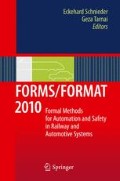Abstract
Usually, risk assessments are done qualitatively or quantitatively. Neither of these two approaches is satisfactory. In the future, risk assessment methods combining the advantages of both approaches are recommendable. Based on the life cycle process as described in DIN EN 50126, the paper discusses guidelines for the construction of semi-quantitative risk assessment methods and presents a newly developed semi-quantitative risk graph for the application to the railway sector.
Access this chapter
Tax calculation will be finalised at checkout
Purchases are for personal use only
Preview
Unable to display preview. Download preview PDF.
References
Milius, B.: A New Classification for Risk Assessment Methods. In: Proceedings of 6th Symposium FORMS/FORMAT 2007 - “Formal Methods for Automation and Safety in Railway and Automotive Systems” 25th - 26th January 2007.
Functional safety of electrical/electronic/programmable electronic safetyrelated systems - Part 1: General requirements (IEC 61508-1:1998 + Corrigendum 1999); German version EN 61508-1:2001 /bibitem14.3 Verband Deutscher Verkehrsunternehmen: VDV 332: Sicherheitsintegritätsanforderungen für Bahnsignalanlagen bei Nichtbundeseigenen Eisenbahnen (NE). Juli 2008
Milius, B.: Konstruktion eines semi-qualitativen Risikographen für das Eisenbahnwesen. Dissertation. December 2009. http://rzbl04.biblio.etc.tu-bs.de:8080/docportal/receive/DocPortal_document_00031882
Railway applications - The specification and demonstration of reliability, availability, maintainability and safety (RAMS); German version EN 50126:1999
Braband, J.: Risikoanalysen in der Eisenbahn-Autommatisierung. Herausgegeben von der Siemens AG, 2005
Milius, Birgit: Severity of Harm in Semi-Quantitative Risk Assessment Method. In: Proceedings of the Fourth International Conference on System Safety 26 -28 October 2009, Savoy Place, London, UK.
Union Internationale des Chemines de Fer: Generic Hazard ListMethodology for Railway Signaling, 2007.
Commission regulation (EC) No 352/2009 of 24 April 2009 on the adoption of a common safety method on risk evaluation and assessment as referred to in Article 6(3)(a) of Directive 2004/49/EC of the European Parliament and of the Council
Author information
Authors and Affiliations
Corresponding author
Editor information
Editors and Affiliations
Rights and permissions
Copyright information
© 2011 Springer-Verlag Berlin Heidelberg
About this paper
Cite this paper
Milius, B. (2011). Designing a semi-quantitative risk graph. In: Schnieder, E., Tarnai, G. (eds) FORMS/FORMAT 2010. Springer, Berlin, Heidelberg. https://doi.org/10.1007/978-3-642-14261-1_18
Download citation
DOI: https://doi.org/10.1007/978-3-642-14261-1_18
Published:
Publisher Name: Springer, Berlin, Heidelberg
Print ISBN: 978-3-642-14260-4
Online ISBN: 978-3-642-14261-1
eBook Packages: EngineeringEngineering (R0)

